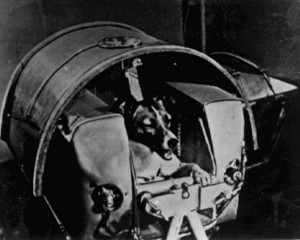Earth’s Extraterrestrial Animals
Before NASA propelled earth’s first man into orbit, the space program sent our species’ closest relative.
A chimpanzee named Ham achieved world fame as an American “astro-chimp” after exceeding our planet’s boundaries on January 1st, 1961. Though monumental, Ham’s space voyage was not out of the ordinary during this era in history.
According to eas.sa.edu, the U.S. and Soviet space programs have launched innumerable other animals above our atmosphere since growing curious in space exploration in the late 1940’s. The site states that “Apart from dogs and primates many other animals and living creatures have been launched towards space or into space.”
Fruit flies, various rodents, turtles and microorganisms are among the very first pioneers of astronautics.
NASA justifies using animals as test subjects by stating it was necessary to discover essential, previously unknown information on how breathing organisms, like humans, react to extraterrestrial environments.
“Scientists couldn’t agree on what it would be like for a living organism to leave Earth’s atmosphere,” said howstuffworks writer John Fuller. “Instead of sending people up in such a risky situation, the United States and Russia sent monkeys, chimps, dogs and other animals into space in order to analyze such effects.”
While many of these animals returned from their missions as national heroes, advocates protecting the interest of these beings have been forced to question the ethics of animal space travel.
On several occasions, flight malfunctions were to blame for inflicting severe strain, anxiety, pain and even fatalities in the animal kingdom’s selection of galactic trailblazers.
Ham the chimpanzee’s famed mission is no exception. Throughout the duration of his “sixteen and a half minute” journey with Project Mercury, the astro-chimp experienced alarming variations in pressure, but ultimately only suffered a broken nose according toabsoluteastronomy.com.
This outcome proved more positive than the realistic possibility of failure of the specialized suit he wore preventing the tremendous force of liftoff from crushing his fragile body. Mission coordinators also had to take in account and avoid the complications of past experiments gone wrong that led to test-subject casualties.
Arguably the most famous of which is the death of a former stray Russian dog, turned astronaut named Laika, who was the first earthling to live and die in orbit.
Using animals in space programs has not ceased. Recently, worms aboard the Columbia space shuttle tragedy were found alive in wreckage and in 2010 NASA announced its plan to irradiate squirrel monkeys “to learn about the potential long-term effects of radiation in space, hoping to use the information to plan human travel to Mars,” say NASA spokesman Grey Hautaluoma.
Ian O’Neill on universetoday.com says that fifty-one years later in 2008, a monument was built in Russia to commemorate Laika. Though a thoughtful sentiment, supporters of animal rights argue Laika’s survival should have been the main priority during that mission.
Kathleen Conlee, director of program management for the Humane Society of the US, claims, “Just because you’re using a primate doesn’t mean that you’re going to get the results a human would.”
No matter your stance on the issue of using test-subjects against their will, the positive contributions of animals to space exploration are indisputable.
